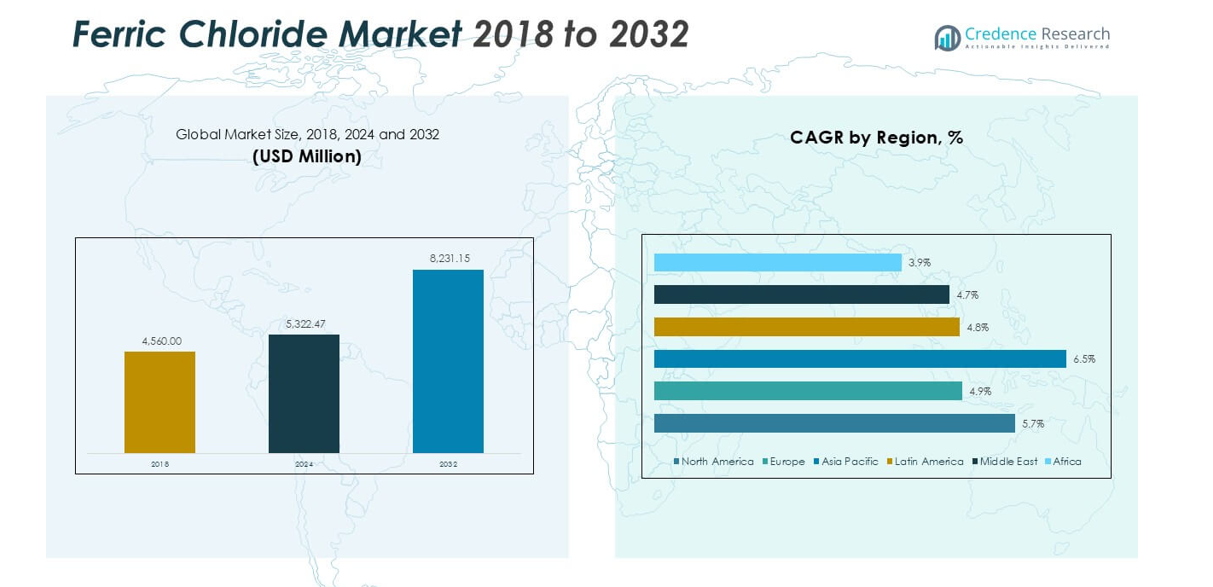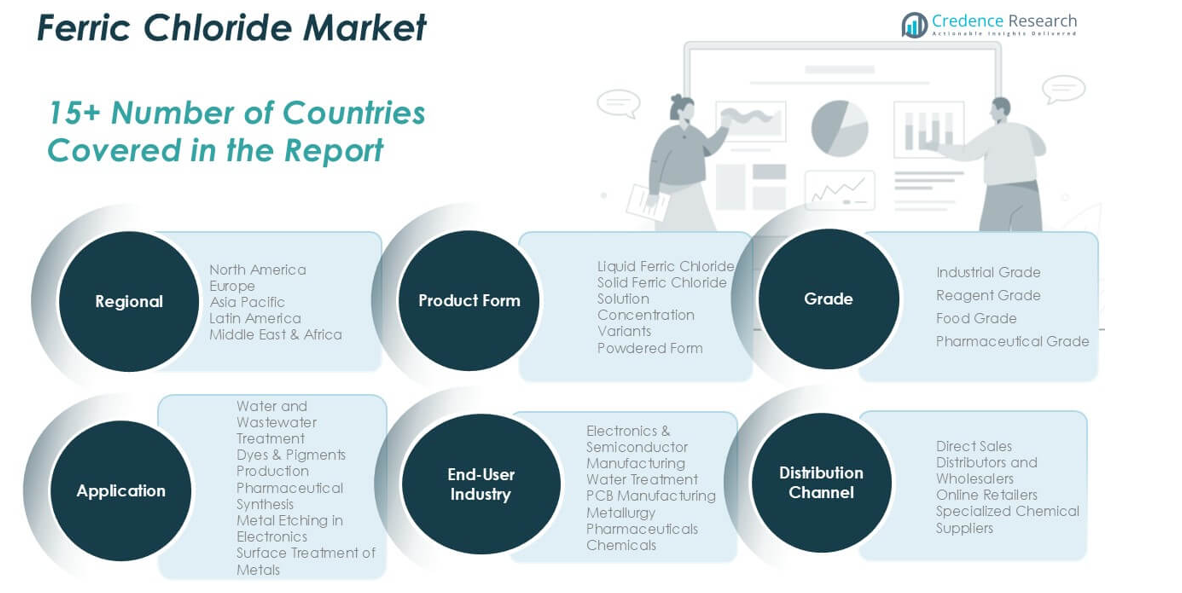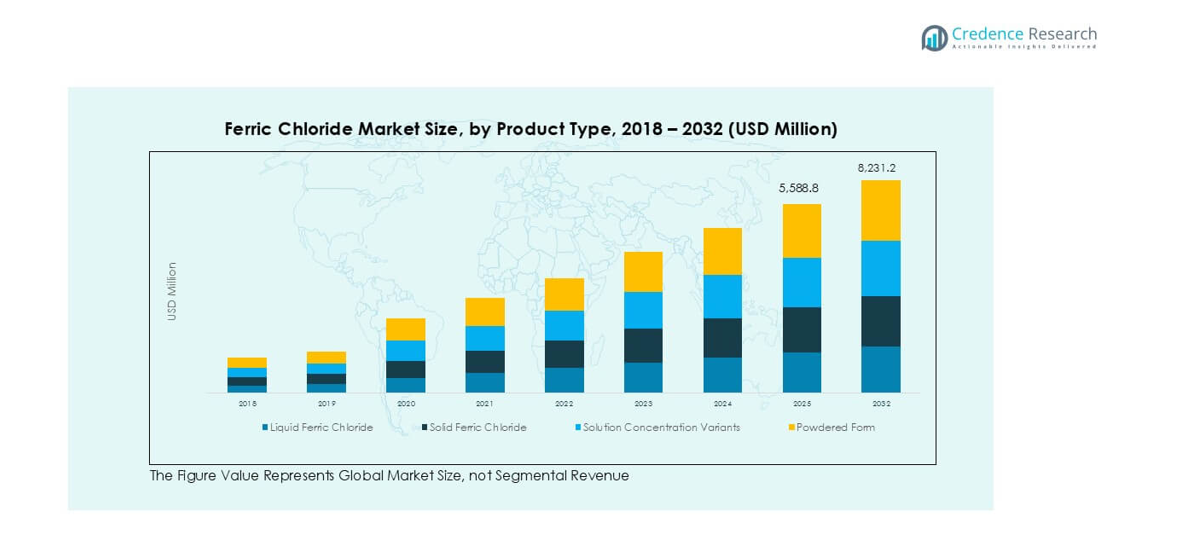CHAPTER NO. 1 : GENESIS OF THE MARKET
1.1 Market Prelude – Introduction & Scope
1.2 The Big Picture – Objectives & Vision
1.3 Strategic Edge – Unique Value Proposition
1.4 Stakeholder Compass – Key Beneficiaries
CHAPTER NO. 2 : EXECUTIVE LENS
2.1 Pulse of the Industry – Market Snapshot
2.2 Growth Arc – Revenue Projections (USD Million)
2.3. Premium Insights – Based on Primary Interviews
CHAPTER NO. 3 : FERRIC CHLORIDE MARKET FORCES & INDUSTRY PULSE
3.1 Foundations of Change – Market Overview
3.2 Catalysts of Expansion – Key Market Drivers
3.2.1 Momentum Boosters – Growth Triggers
3.2.2 Innovation Fuel – Disruptive Technologies
3.3 Headwinds & Crosswinds – Market Restraints
3.3.1 Regulatory Tides – Compliance Challenges
3.3.2 Economic Frictions – Inflationary Pressures
3.4 Untapped Horizons – Growth Potential & Opportunities
3.5 Strategic Navigation – Industry Frameworks
3.5.1 Market Equilibrium – Porter’s Five Forces
3.5.2 Ecosystem Dynamics – Value Chain Analysis
3.5.3 Macro Forces – PESTEL Breakdown
3.6 Price Trend Analysis
3.6.1 Regional Price Trend
3.6.2 Price Trend by product
CHAPTER NO. 4 : KEY INVESTMENT EPICENTER
4.1 Regional Goldmines – High-Growth Geographies
4.2 ApplicationFrontiers – Lucrative ApplicationCategories
4.3 ApplicationSweet Spots – Emerging Demand Segments
CHAPTER NO. 5: REVENUE TRAJECTORY & WEALTH MAPPING
5.1 Momentum Metrics – Forecast & Growth Curves
5.2 Regional Revenue Footprint – Market Share Insights
5.3 Segmental Wealth Flow – Product Form & ApplicationRevenue
CHAPTER NO. 6 : TRADE & COMMERCE ANALYSIS
6.1. Import Analysis by Region
6.1.1. Global Ferric Chloride Market Import Revenue By Region
6.2. Export Analysis by Region
6.2.1. Global Ferric Chloride Market Export Revenue By Region
CHAPTER NO. 7 : COMPETITION ANALYSIS
7.1. Company Market Share Analysis
7.1.1. Global Ferric Chloride Market: Company Market Share
7.2. Global Ferric Chloride Market Company Revenue Market Share
7.3. Strategic Developments
7.3.1. Acquisitions & Mergers
7.3.2. New ApplicationLaunch
7.3.3. Regional Expansion
7.4. Competitive Dashboard
7.5. Company Assessment Metrics, 2024
CHAPTER NO. 8 : FERRIC CHLORIDE MARKET – BY PRODUCT FORM SEGMENT ANALYSIS
8.1. Ferric Chloride Market Overview by Product Form Segment
8.1.1. Ferric Chloride Market Revenue Share By Product Form
8.2. Liquid Ferric Chloride
8.3. Solid Ferric Chloride
8.4. Solution Concentration Variants
8.5. Powdered Form
CHAPTER NO. 9 : FERRIC CHLORIDE MARKET – BY APPLICATION SEGMENT ANALYSIS
9.1. Ferric Chloride Market Overview by Application Segment
9.1.1. Ferric Chloride Market Revenue Share By Application
9.2. Water and Wastewater Treatment
9.3. Dyes & Pigments Production
9.4. Pharmaceutical Synthesis
9.5. Metal Etching in Electronics
9.6. Surface Treatment of Metals
CHAPTER NO. 10 : FERRIC CHLORIDE MARKET – BY GRADE SEGMENT ANALYSIS
10.1. Ferric Chloride Market Overview by Grade Segment
10.1.1. Ferric Chloride Market Revenue Share By Grade
10.2. Industrial Grade
10.3. Reagent Grade
10.4. Food Grade
10.5. Pharmaceutical Grade
CHAPTER NO. 11 : FERRIC CHLORIDE MARKET – BY END-USER INDUSTRY SEGMENT ANALYSIS
11.1. Ferric Chloride Market Overview by End-User Industry Segment
11.1.1. Ferric Chloride Market Revenue Share By End-User Industry
11.2. Electronics & Semiconductor Manufacturing
11.3. Water Treatment
11.4. PCB Manufacturing
11.5. Metallurgy
11.6. Pharmaceuticals
11.7. Chemicals
CHAPTER NO. 12 : FERRIC CHLORIDE MARKET – BY DISTRIBUTION CHANNEL SEGMENT ANALYSIS
12.1. Ferric Chloride Market Overview by Distribution Channel Segment
12.1.1. Ferric Chloride Market Revenue Share By Distribution Channel
12.2. Direct Sales
12.3. Distributors and Wholesalers
12.4. Online Retailers
12.5. Specialized Chemical Suppliers
CHAPTER NO. 13 : FERRIC CHLORIDE MARKET – REGIONAL ANALYSIS
13.1. Ferric Chloride Market Overview by Region Segment
13.1.1. Global Ferric Chloride Market Revenue Share By Region
13.1.2. Regions
13.1.3. Global Ferric Chloride Market Revenue By Region
13.1.4. Product Form
13.1.5. Global Ferric Chloride Market Revenue By Product Form
13.1.6. Application
13.1.7. Global Ferric Chloride Market Revenue By Application
13.1.8. Grade
13.1.9. Global Ferric Chloride Market Revenue By Grade
13.1.10. End-User Industry
13.1.12. Global Ferric Chloride Market Revenue By End-User Industry
13.1.13. Distribution Channel
13.1.14. Global Ferric Chloride Market Revenue By Distribution Channel
CHAPTER NO. 14 : NORTH AMERICA FERRIC CHLORIDE MARKET – COUNTRY ANALYSIS
14.1. North America Ferric Chloride Market Overview by Country Segment
14.1.1. North America Ferric Chloride Market Revenue Share By Region
14.2. North America
14.2.1. North America Ferric Chloride Market Revenue By Country
14.2.2. Product Form
14.2.3. North America Ferric Chloride Market Revenue By Product Form
14.2.4. Application
14.2.5. North America Ferric Chloride Market Revenue By Application
14.2.6. Grade
14.2.7. North America Ferric Chloride Market Revenue By Grade
14.2.8. End-User Industry
14.2.9. North America Ferric Chloride Market Revenue By End-User Industry
14.2.10. Distribution Channel
14.2.11. North America Ferric Chloride Market Revenue By Distribution Channel
14.3. U.S.
14.4. Canada
14.5. Mexico
CHAPTER NO. 15 : EUROPE FERRIC CHLORIDE MARKET – COUNTRY ANALYSIS
15.1. Europe Ferric Chloride Market Overview by Country Segment
15.1.1. Europe Ferric Chloride Market Revenue Share By Region
15.2. Europe
15.2.1. Europe Ferric Chloride Market Revenue By Country
15.2.2. Product Form
15.2.3. Europe Ferric Chloride Market Revenue By Product Form
15.2.4. Application
15.2.5. Europe Ferric Chloride Market Revenue By Application
15.2.6. Grade
15.2.7. Europe Ferric Chloride Market Revenue By Grade
15.2.8. End-User Industry
15.2.9. Europe Ferric Chloride Market Revenue By End-User Industry
15.2.10. Distribution Channel
15.2.11. Europe Ferric Chloride Market Revenue By Distribution Channel
15.3. UK
15.4. France
15.5. Germany
15.6. Italy
15.7. Spain
15.8. Russia
15.9. Rest of Europe
CHAPTER NO. 16 : ASIA PACIFIC FERRIC CHLORIDE MARKET – COUNTRY ANALYSIS
16.1. Asia Pacific Ferric Chloride Market Overview by Country Segment
16.1.1. Asia Pacific Ferric Chloride Market Revenue Share By Region
16.2. Asia Pacific
16.2.1. Asia Pacific Ferric Chloride Market Revenue By Country
16.2.2. Product Form
16.2.3. Asia Pacific Ferric Chloride Market Revenue By Product Form
16.2.4. Application
16.2.5. Asia Pacific Ferric Chloride Market Revenue By Application
16.2.6. Grade
16.2.7. Asia Pacific Ferric Chloride Market Revenue By Grade
16.2.8. End-User Industry
16.2.9. Asia Pacific Ferric Chloride Market Revenue By End-User Industry
16.2.10. Distribution Channel
16.2.11. Asia Pacific Ferric Chloride Market Revenue By Distribution Channel
16.3. China
16.4. Japan
16.5. South Korea
16.6. India
16.7. Australia
16.8. Southeast Asia
16.9. Rest of Asia Pacific
CHAPTER NO. 17 : LATIN AMERICA FERRIC CHLORIDE MARKET – COUNTRY ANALYSIS
17.1. Latin America Ferric Chloride Market Overview by Country Segment
17.1.1. Latin America Ferric Chloride Market Revenue Share By Region
17.2. Latin America
17.2.1. Latin America Ferric Chloride Market Revenue By Country
17.2.2. Product Form
17.2.3. Latin America Ferric Chloride Market Revenue By Product Form
17.2.4. Application
17.2.5. Latin America Ferric Chloride Market Revenue By Application
17.2.6. Grade
17.2.7. Latin America Ferric Chloride Market Revenue By Grade
17.2.8. End-User Industry
17.2.9. Latin America Ferric Chloride Market Revenue By End-User Industry
17.2.10. Distribution Channel
17.2.11. Latin America Ferric Chloride Market Revenue By Distribution Channel
17.3. Brazil
17.4. Argentina
17.5. Rest of Latin America
CHAPTER NO. 18 : MIDDLE EAST FERRIC CHLORIDE MARKET – COUNTRY ANALYSIS
18.1. Middle East Ferric Chloride Market Overview by Country Segment
18.1.1. Middle East Ferric Chloride Market Revenue Share By Region
18.2. Middle East
18.2.1. Middle East Ferric Chloride Market Revenue By Country
18.2.2. Product Form
18.2.3. Middle East Ferric Chloride Market Revenue By Product Form
18.2.4. Application
18.2.5. Middle East Ferric Chloride Market Revenue By Application
18.2.6. Grade
18.2.7. Middle East Ferric Chloride Market Revenue By Grade
18.2.8. End-User Industry
18.2.9. Middle East Ferric Chloride Market Revenue By End-User Industry
18.2.10. Distribution Channel
18.2.11. Middle East Ferric Chloride Market Revenue By Distribution Channel
18.3. GCC Countries
18.4. Israel
18.5. Turkey
18.6. Rest of Middle East
CHAPTER NO. 19 : AFRICA FERRIC CHLORIDE MARKET – COUNTRY ANALYSIS
19.1. Africa Ferric Chloride Market Overview by Country Segment
19.1.1. Africa Ferric Chloride Market Revenue Share By Region
19.2. Africa
19.2.1. Africa Ferric Chloride Market Revenue By Country
19.2.2. Product Form
19.2.3. Africa Ferric Chloride Market Revenue By Product Form
19.2.4. Application
19.2.5. Africa Ferric Chloride Market Revenue By Application
19.2.6. Grade
19.2.7. Africa Ferric Chloride Market Revenue By Grade
19.2.8. End-User Industry
19.2.9. Africa Ferric Chloride Market Revenue By End-User Industry
19.2.10. Distribution Channel
19.2.11. Africa Ferric Chloride Market Revenue By Distribution Channel
19.3. South Africa
19.4. Egypt
19.5. Rest of Africa
CHAPTER NO. 20 : COMPANY PROFILES
20.1. Kemira
20.1.1. Company Overview
20.1.2. ApplicationPortfolio
20.1.3. Financial Overview
20.1.4. Recent Developments
20.1.5. Growth Strategy
20.1.6. SWOT Analysis
20.2. Tessenderlo Group
20.3. PVS Chemicals
20.4. BorsodChem
20.5. Feracid
20.6. SIDRA Wasserchemie
20.7. Basic Chemical Industries
20.8. Chemiflo
20.9. Gulbrandsen
20.10. Philbro-Tech
20.11. Malay Sino Chemical Industries
20.12. Saf Sulphur Company
20.13. BASF
20.14. Sukha Chemical Industries
20.15. Zhongzheng Chemical










